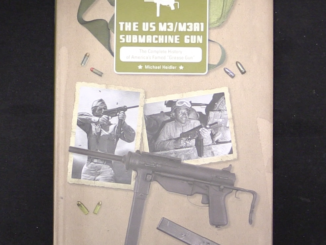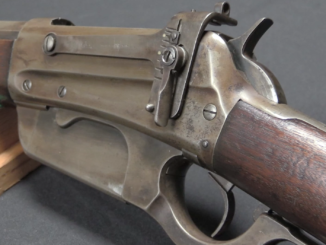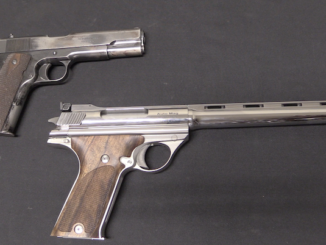Is the Stoner 63 really as good of a gun as everyone says? Today is my first opportunity to try one out on the range, and I’m going to look at it in three different configurations: the Mk23 SEAL light machine gun, the “Bren” style automatic rifle, and the carbine. Let’s see how it handles!
I owe a tremendous thanks to Movie Armaments Group in Toronto for the opportunity to take the Stoner kit out to the range! Check them out on Instagram to see many of the guns in their extensive collection: https://instagram.com/moviearmamentsgroup
Contact:
Forgotten Weapons
PO Box 87647
Tucson, AZ 85754




Fantastic video, Ian. What were the problems with the Stoner System that caused the U.S. Military to not adopt at least the belt fed and magazine fed machine guns.
Parts breakage that got progressively worse after couple 1000s of rounds.
Stoner 63 was tested in Yugoslavia in 1969. as an potential weapons for a paratroopers, but it turned out that after average 2500-3000 rounds through each weapon parts started breaking at unacceptable rate, which put an end to a tests.
Maybe it was made too light?
When Soviet Union acquired sample of U.S. M60, they decided that they also need lighter general-purpose machine gun, that finally ended with PKM, but there existed competitor – ТКБ-015, see photos: http://www.dogswar.ru/oryjeinaia-ekzotika/strelkovoe-oryjie/5831-opytnyi-pylemet-niki.html
with empty mass 6,1 kg, but proved to be less reliable than PKM in adverse environment and having some problems with heat dissipation.
My bet would be metallurgy as applied to individual parts. That is what usually makes guns to break too soon. I wonder what would be the outcome if HK had their hand on it.
Let’s not forget, there is two kinds of designing: one is for function and he other for durability. Who masters the second is the winner.
According to https://www.youtube.com/watch?v=-Zb8OgPwf5Q
…the catch with it is they said it was very meticulous very temperamental weapon and it certainly wasn’t for everybody if you didn’t(…)keep it clean you were going to have issues…
The point is that the Stoner 63 system was good for specialists, but not good for ordinary grunts. This is probably the reason why the Nikonov can’t replace the AK rifles; too freakishly complicated for conscripted/emergency-drafted people. And let’s not even get into the issues of the SA-80. As Kalashnikov himself said, a standard infantry rifle must be an item that any random soldier can operate and maintain. “Evidently, British soldiers must all be geniuses.”
End of war in ‘Nam, and to much complex design for ordinary troops.
Aa a member of USMC Plt. 236 PISC (Stoner Plt.) we participated in a test of the Stoner 63 weapon system in 1964. We were issued the weapon instead of the standard M-14 and took it thru a normal 12-13 week training cycle qualifying with it at the rifle range. From Parris Island the weapon system and different comfigurations of it were further tested at ITR and with A-1-8 (8th) Marines at Camp Lejeune. Upon completion of the test members of the Stoner Plt. were dispersed to various units through out the Corps.
Many years back (1972) I saw a couple of SEALs at the end of one of those operations that didn’t happen. I wasn’t a shooter at the time but I remember that their weapons didn’t look “right” – that is they weren’t the early model M-16s I was used to seeing. Later on I realized that the SEALs were carrying Stoners. After our doc patched them up they climbed into an unmarked dark grey copter and headed to a place that didn’t exist to do other stuff that never happened.
“Mk23 SEAL light machine gun”
In Soviet Union somewhat similar weapon was developed in 1970s namely ПУ-21
http://www.dogswar.ru/oryjeinaia-ekzotika/strelkovoe-oryjie/3998-pylemet-py-21-rossi.html
5,45×39 machine gun, able to be fed from magazine (30 or 45) or belt (200), empty mass 5,7 kg, mass ready to action with belt: 8,5 kg.
According to Russian wikipedia query one of reasons was impossibility of crafting of “Rakov’s Gadget” for 5,45×39 cartridge (mechanical device for placing cartridges into belt)
One of aftereffects of this project was special belt-feeder for RPK-74, which could be used without modification of RPK-74, it also never go beyond prototype stage:
https://kalashnikov.media/article/weapons/lenta-dlya-rpk-74
(allowed use of 100 or 200 rounds belts)
Stoner 63 – it’s like the bestest Erector set ever!
Its surprising after all the experimental experience of the last century that controllable recoil can’t be consistently designed into place.
Which brings up the question “why is this gun so controllable?” Is it the tungsten weights in the op-rod? Or maybe the construction method where everything clips on thus producing a really bad tuning fork so that vibrations get damped down quickly? It would be nice to know so designers could copy it. Any ideas?
Low recoil machine gun you need? Could it be 12,7×99? If yes check:
http://fnfal.com/forums/showthread.php?t=76174
Russell Robinson had some interesting ideas about recoil. http://www.smallarmsreview.com/display.article.cfm?idarticles=1985
US patent 3,738,044
Controllability has probably more to do with the barrel axis in relation to the stock. In machine gun mode, the barrel axis is in line with the stock. In rifle / carbine mode, the barrel axis is over the top of the stock.
In line stocks sure help with recoil. They are not all created equal. The FG-42 is one example. Ian interviewed Jim Sullivan (who was involved with this gun) and along with Karl got to fire one of his recoil reducing guns. https://www.youtube.com/watch?v=gOUKXIrDE0I
That’s backwards, though — the machine gun/automatic rifle modes have the barrel high and gas tube low, while the rifle/carbine modes have the barrel low and gas tube high.
Still, I think you have the right idea, only it’s not the centerline of the barrel that matters as much as the center-of-mass of reciprocating parts. In a long-stroke gas piston setup like this, much of the weight is in or aligned with the gas piston, so the barrel-high configurations have the moving mass more in line with the stock.
I don’t disagree, I just think there are subtleties involved in the design. They may only add up to a couple of per cent, but still. If one considers the magazine as part of the reciprocating parts, it is still moving rearward as the carrier begins to move forward, the same with the buffer weights. It night seem like picking nits, but Mr. Newton is keeping score.
Operating parts positioning is way more important than a barrel position.
PKM feels “smoother” than AK, due the operating parts being under the barrel and both being in line to the stock.
AK feels “rougher” because oprod is over the already relatively high barrel axis.
I’d say the secret of controllability is in the machine gun config. open bolt mode, more than any barrel alignment.
Is it not because action does not bottom on buffer; so called constant recoil? Most of automatic weapons movement during full auto fire is generated right there.
I agree, just watch Ian fire his Chauchat. It just seems like the anti bounce weights would kind of anti bounce at the rear also. One theory about buffer weights for the AR-15 is that it is dependent on the barrel weight and not the weight of the gun. A heavier barrel requires a heavier buffer to slow the carrier down. Presumably the rest of the gun is loosely coupled to the barrel and acts as an inertial weight until after unlocking and carrier velocity is determined. By the same logic the carrier on the heavy barreled Stoner MG would be higher than the rifle. From Small Arms Solutions https://www.youtube.com/watch?v=DYf-MLMODhA I hope I didn’t butcher his idea too much.
Ian: re belt-fed vs Bren configuration Stoner
But what if the Bren configuration Stoner used 45 round magazines like the RPK-74 or 50 round magazines like the Galil? Does the belt-Fed stoner really have much advantage then in firepower?
I think that a Bren style LMG in 5.56mm (or 5.45mm) would still be an excellent weapon system today.
Top mounted magazine are a thing of the past. Optical sight are now the norm even for machine-guns. Where are you going to mount an optic with the magazine sticking from the top?
Only a thing of the past? That’s pretty ironic, considering even as far back as WWII the Japanese were using optical sights with Bren configuration LMG!
In fact, the modern type of optical sights now available and soon to be available make top mounted magazines more practical today than they ever were before.
“Japanese were using optical sights with Bren configuration LMG!”
With box magazines. As long as you would limit yourself to use solely stick or banana magazines magazine sticking upwards should work okay, but what if you already have drum magazines available, like for example: http://modernfirearms.net/en/machineguns/russia-machineguns/rpk-16-eng/ ?
“Does the belt-Fed stoner really have much advantage then in firepower?”
Well, regarding belt-fed vs magazine-fed: difference in volume of bullets you can send down the barrel might be small, but what is important is mass of ammunition including magazine/belt. So with belts you could carry more ammunition for some mass.
“Bren style LMG in 5.56mm (or 5.45mm) would still be an excellent weapon system today.”
In Russia new box-belt-fed for 5,45 mm was created, namely Tokar-2
https://www.thefirearmblog.com/blog/2017/06/16/russian-saw-tokar-2-5-45x39mm-belt-fed-light-machine-gun-showed-off-national-guard-open-house-2017/
when using magazines they are sticking downwards
With the light weight of modern design box magazines, it’s debatable if belt fed 5.56mm M193 (or M855a1) has any advantage in ammo weight, because spare belts are typically carried in boxes themselves.
More importantly, a magazine fed LMG will be simpler, cheaper, smoother shooting and more reliable than a comparable belt fed LMG. Which is more important than tiny differences in weight of ammunition.
But aren’t you comparing polymer box magazines with metallic links, which is technology level, let me think… of Great War (cf. Prideaux link http://www.smallarmsreview.com/display.article.cfm?idarticles=400 )?
Maybe it is time to update links? Check this polymer belt for Kalashnikov’s 7,62 mm machine gun: https://pikabu.ru/story/plastikovaya_patronnaya_lenta_dlya_pkm_5992103
one link two times lighter than metallic.
If you are wondering why on photo link is coming out of peculiar container – it is low temperature test.
Ian, a litle correction about the bayonets: Soligen is not their maker. It is a German town well known for its knives industry. One of those company is Eickhorn (whose logo is a squirrel) and they still make bayonets nowadays.
Why does a top-mounted mag have to be in dead center? The venerable Madsen LMG put it off to the left (see Ian’s vids on that funny old iron), still vertical but out of the way of the sights. Pedersen canted his famous Device’s 40-rd mag to the right, leaving the sights clear and still allowing easy prone shooting and, I think, probably easy reloading.
The Pedersen rifle is a good addition to the H3VR game’s list of obscurely known firearms to augment its competitor the M1 Garand.
Ian,
Have you ever investigated the connections between the bolt carrier and the bolt cam. There seems to be buffering arrangement similar to the Bren. I believe that it could be the reason that the gun works so well. However Dr. Karl Maier carried out some high speed photography on the Stoner and told me that the carrier bounced badly
Another video on the Stoner by someone who used them is “Shoiting the Stoner Machinegun; A Navy Seal Remembers” by Michael Walsh.
Ian, so the wife wants to know: @ 7ish, are those ducks we’re hearing in the background?
I recently mocked up a BREN style AR, complete w/ carry handle, and twin 45 degree mounts holding a red dot. It needs further experimentation and perhaps a DOLOS system.
Whenever I see a Stoner – I’m immediately reminded of the AR-180 – a rifle which was initially designed to fulfill, “planned obsolescence” for the third world countries it was especially designed for.
The Stoner is literally made of hundreds of small stamped, turned and cast parts and sometimes very nicely welded together. Truly, looking closely at it, nothing will convince you of its ruggedness and near-unfailing life span on the battlefield.
Both guns were designed far too lightly and even the AR-180 in civilian hands would still have caused problems. All you need to do is study the bolt hold-open pawl and folding stock mechanism – both FAR too weak. I’m sure it suffered from other underdesigned aspects. If it had been allowed to ‘breathe’, the overall design would have been strengthened far beyond what it remained to stay.
The exact same for the Stoner. The Stoner System may have been unbeatable on paper but if the individual parts of that system would fall by the wayside because of initial light weight design, none of the ‘attaching’ systems would have been given the tax Dollars to ensure continued longevity.
HAD those Dollars been allocated to the Stoner and AR-180, the guns we see today would all have be part of an exceptionally early development program.
The Stoner 63 seems a stroke of genius. Flip it over and its a rifle, flip it back and its a belt fed machine gun, flip it sideways and it makes toast. It would be interesting to scale it up a hair for the new 6.8 round and call it the Stoner 68…
I read that Knights Armament has the drawings for the Stoner 63. Wonder if they are interested?